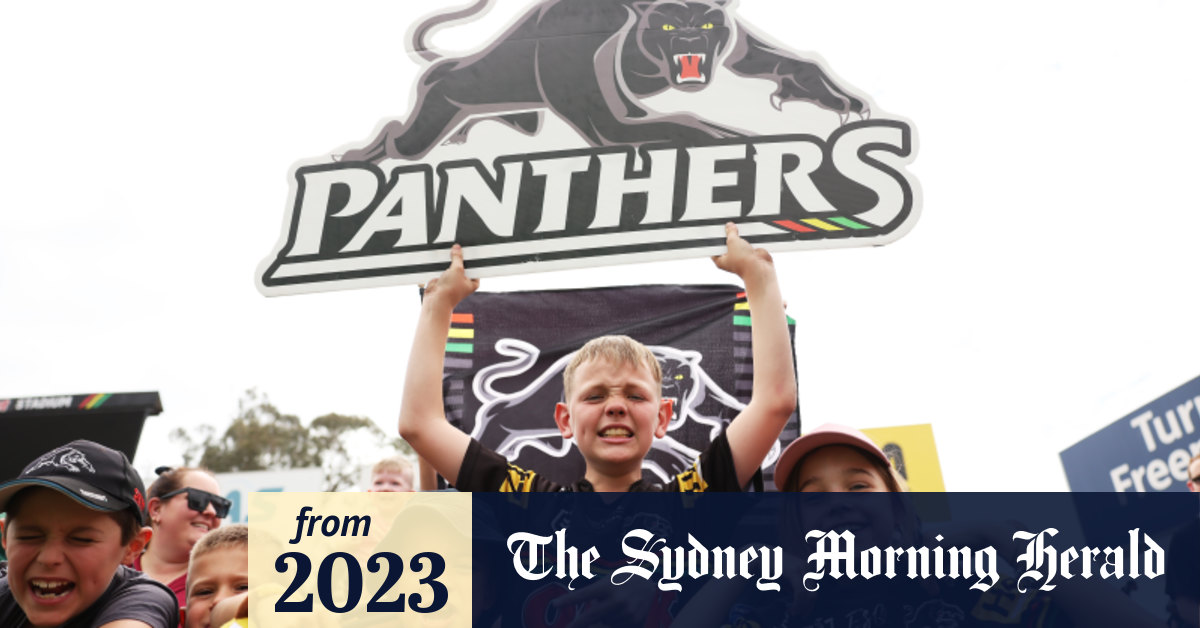Big Cat Empire: How Penrith went from giving away tickets to a Sydney superclub
In 2013, Penrith recruitment manager Jim Jones stood in front of 80 teenage rugby league players at Carrington Park in Bathurst in the NSW Central Tablelands.
Two years earlier, the Panthers had decided to expand their already enormous junior nursery to take in Western Division, so they held a camp for players aged from 13 to 16.
When the camp concluded, the young players gathered for a photo in front of the scoreboard, which was sponsored by the Panthers’ leagues club in Bathurst.
“Thanks for coming today,” Jones said, before adding: “Now, who follows Penrith?”
Only two players stood up.
“Then one sat down!” Jones roars as he retells the story. “We had one kid!”
Standing alongside Jones that day was Matt Cameron, who joined the club in 2012 to oversee the Panthers’ pathways but is now chief executive of football.
When he returned to Penrith, he enlarged two team photos taken at the camp and asked to meet with the board.
“We’ve got a club in the main street, but no one likes us out there,” he explained, pointing out that no player was wearing Penrith gear.
Fast-forward a decade and the change in Penrith is reflected in the change of colour in the talented kids who attend their camps in Bathurst.
“I was there last weekend,” Jones says. “Everyone is wearing Panthers gear. Their second team is Penrith.” As Cameron puts it: “Those 16-year-old kids see Penrith as the viable option to be a professional rugby league player.”
In the cranky cut and thrust of rugby league, people struggle to praise rival clubs, especially the successful ones. Panthers players have been branded arrogant and the club has endured constant speculation about how they’ve kept so many of their up-and-coming stars for so long.
“The cap isn’t a difficult thing to manage,” Cameron says. “It is when you attach emotion to it. I don’t coach the team – I worry about the numbers. If you understand you can’t keep all the best players, and especially in a situation when we have good young kids coming through, it’s easy to manage.”
Even the Panthers’ most vocal detractors couldn’t dismiss the incredible reawakening of their club since 2011 when they adopted their “Built from Within” blueprint.
Not that long ago, the Panthers Group – which manages a suite of licensed clubs and the football team – was $112 million in debt. “Ten years ago, we were bleeding money and giving away tickets to watch the footy,” Panthers Group chief executive Brian Fletcher says.
This season, BlueBet Stadium had an average home attendance of about 19,000 – in a 22,500-seat stadium. More than 10,000 attended a fan day earlier this week ahead of Sunday’s grand final against Brisbane.
It will be Penrith’s fourth consecutive appearance in the decider as they chase their third consecutive premiership. Winning is good for business. “We’ve made $26 million from football in the last four years,” Fletcher says. “The previous decade, we lost $50 million out of running the football department. We’ll make a $7 million to $9 million profit this year in merchandise, membership, game-day sponsorship…”
The Panthers have gone from nearly closing the doors to becoming the most dominant team in Australian sport. You need to look at another code to find a worthy comparison: Richmond won three flags over four seasons between 2017 and 2020 while Hawthorn won three consecutive premierships from 2013 to 2015.
Penrith’s chokehold on the NRL doesn’t come about by happenstance, but a clear strategy to make the most of the abundant talent at their fingertips: 24 junior clubs that produced a whopping 8589 players (7378 male, 1211 female) this year.
Some reckon the smartest thing former general manager of football Phil Gould did during his time at Penrith was appointing Cameron as high-performance manager in 2012.
Cameron would never look at it that way, but he quickly realised when he came to Penrith that the children really were their future.
“Gus was bringing in journeyman players who could do what was needed to win first grade games,” Cameron explains. “But Jimmy and I were trying to build a team underneath it. The plan was for those two lines to eventually meet. It came together quicker than we thought it would.”
Cameron performed chiropractic work on the pathways, and it had more to do with coaching than players. He met with coach Ivan Cleary and asked, “If we have a player at 18, what do you want him to look like at 21?”
Instead of fixating on winning junior representative grand finals in the Jersey Flegg (under-21s), SG Ball (under-19s) and Harold Matthews (under-17s) competitions, they became more concerned about using those matches to identify talent.
“We want to give Ivan ready-made first grade players,” Cameron says. “We tell junior coaches we want them to coach the team, but this is a multimillion-dollar business. Our level of coaching for the average 17-year-old player is aligned with what’s going to happen next. We are deeply involved in every aspect in training, selection, recruitment. I feel like we needed to have ownership in the background to produce those players in our system. We’ve got total control.”
Jones has a simpler way of putting it. “Look at our Jersey Flegg team,” he says. “None of them are overweight.”
The veteran recruiter has been unearthing talent for Penrith for more than three decades.

